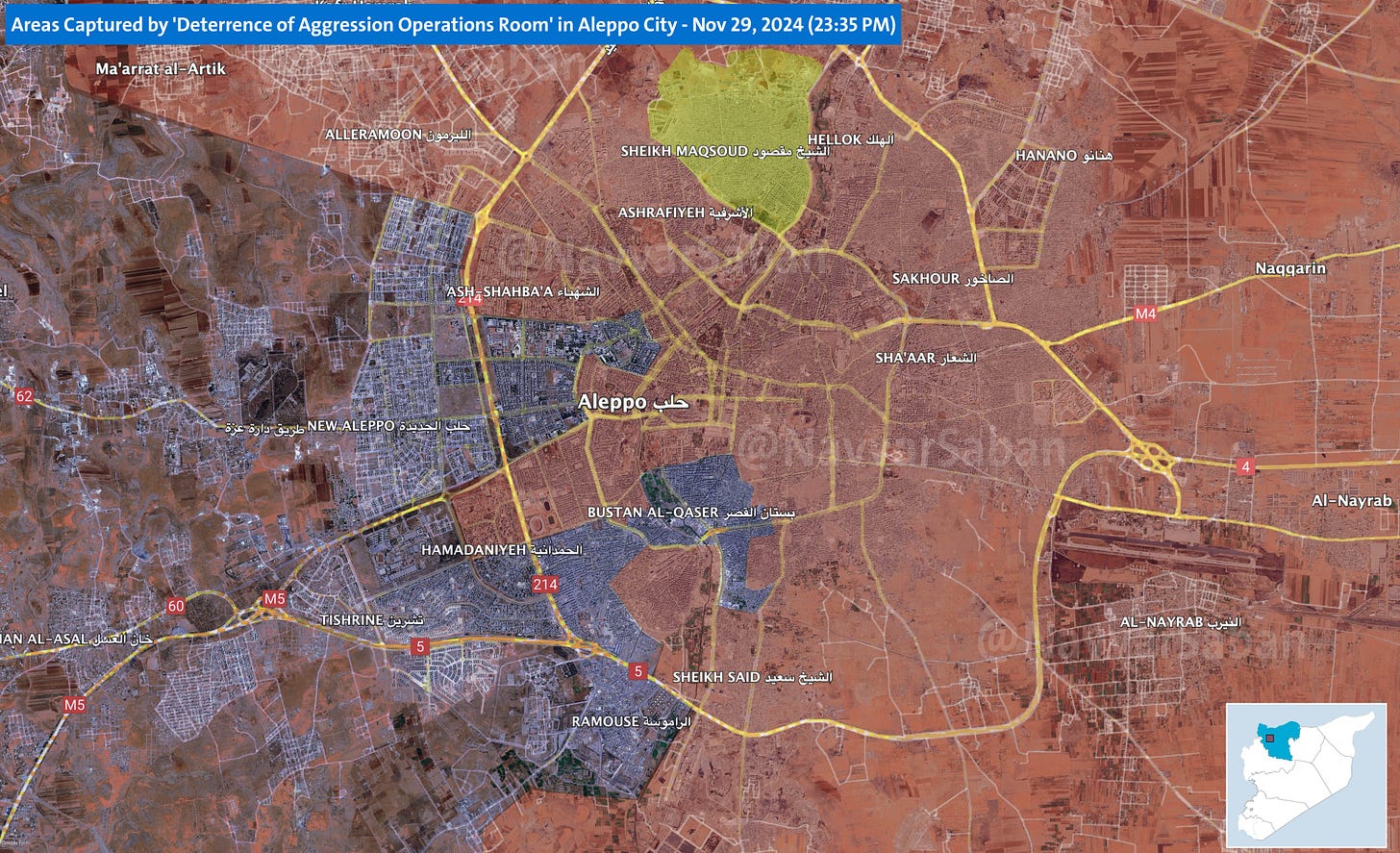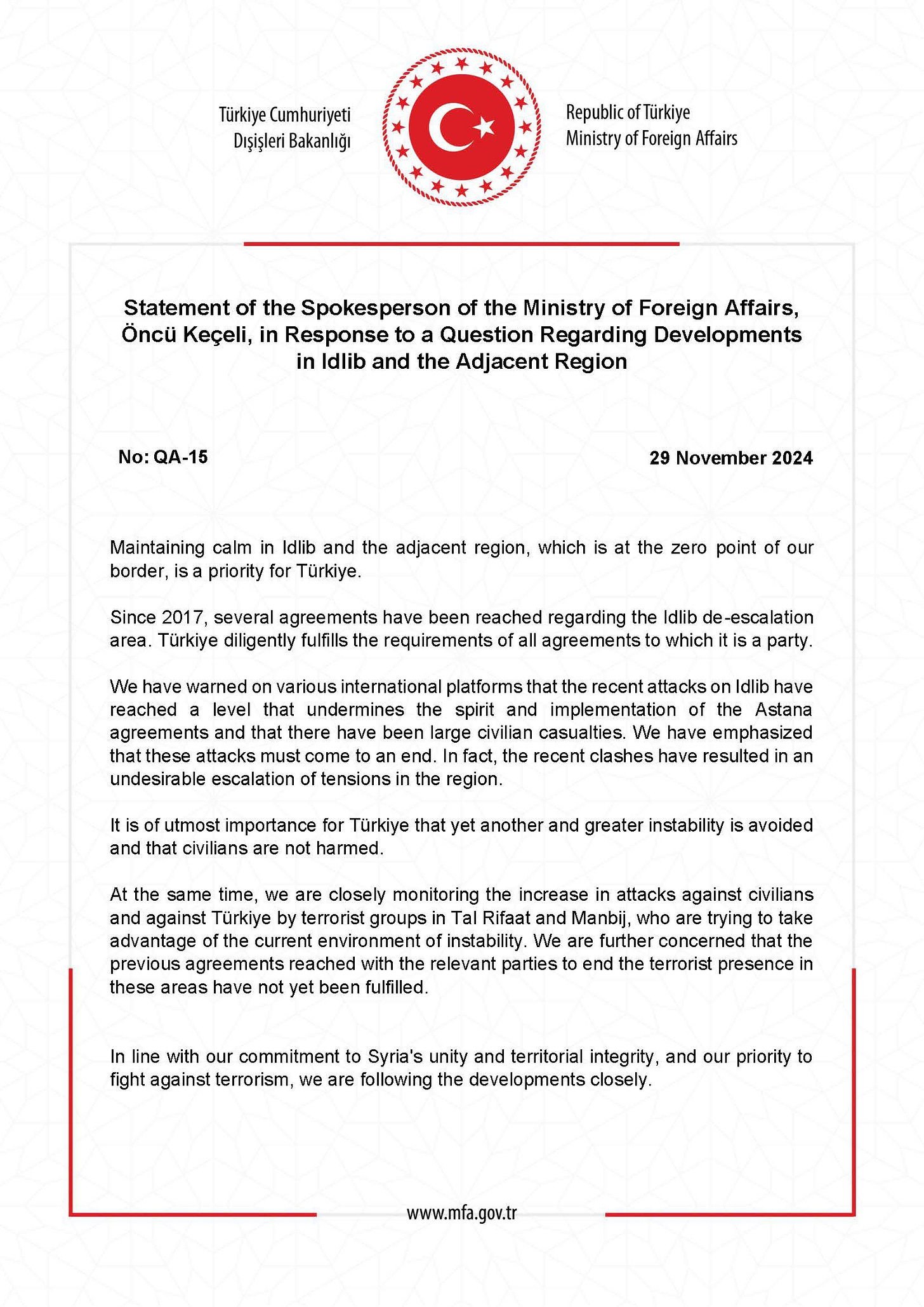Aleppo City is Liberated
The opposition enters Aleppo City for the first time in eight years

Fatah Mubin (FM) forces made their biggest advances of the offensive on November 29. By mid-day, opposition units had broken through the regime’s defensives lines in the suburbs of western Aleppo, capturing and clearing the Hamadaniyeh and New Aleppo suburbs and reaching the city’s ring road by the evening. The first regime reinforcements that arrived in Aleppo late on the 28th had been deployed to these neighborhoods, and their quick collapse seems to have set the regime forces remaining in the city into chaos. After a brief pause, a slew of videos began to emerge throughout the night showing opposition units spreading across the city, cutting through the old city to the eastern neighborhoods. Finally, in the dark, footage was shared online of fighters waving a Free Syrian Army flag on the steps of Aleppo’s famous citadel. Amid the chaos, it seems that opposition forces managed to kill the head of the regime’s Military Intelligence Aleppo Branch, Brigadier General Ali al-Ali.

As the sun rises on the fourth day of the offensive it is unclear just how much of the city has been liberated. Reports of opposition advances into the northern neighborhoods appear sparse, while it is likely that FM forces will quickly finish securing the southern neighborhoods. To the city’s east sits the Aleppo International Airport and Neyrab, both historically strongholds of regime and Iranian militias and military units. It is possible that the regime forces scattered across the city have attempted to regroup here, or they may have withdrawn even further into the eastern countryside. The city of Safira, some eight miles east of Neyrab, is a major Iranian and Syrian militia hub while the Kweires military base, around 17 miles from Neyrab, has become a hub of Russian and regime military forces in recent years.
Opposition forces also made serious progress south of the city. Advances continued across the M5 from Muhandiseen, with opposition forces quickly seizing Khan Touman and then working south to Hader. From Zerbeh and Kafr Halab, units quickly liberated the strategic el-Eiss and continued south to Abed and Hawer el-Eiss. Resistance here seems weak, at best.
Meanwhile the battle for Saraqib raged on. Regime claims of advancing on this front over the previous evening were false, and in the morning the opposition renewed its attempts to storm the town. Three storming attempts were made from Jawbas before fighters were able to break through and begin clearing the city. An hour before sunset the city was largely captured, with cleanup operations and sporadic skirmishes with remaining regime pockets underway. As the sun set, other opposition units moved south, securing Sheikh Idriss and Khan Sabeel. Resistance here was light, according to one opposition soldier, and five tanks were captured in Khan Sabeel alone.
There were additional unconfirmed but seemingly credible reports that the regime abandoned Tel Touqan and Jazraya in the afternoon, withdrawing east likely to Abu Dhuhur, and that small units of opposition fighters had made their way to the villages in the dark. Whatever the case, the opposition will likely be close to if not at Abu Dhuhur sometime on November 30. It remains to be seen if regime forces have attempted to regroup at the adjacent airbase and create a defensive line, or if they will continue to fall back. There have been additional claims throughout the evening that opposition forces advanced south of Khan Sabeel, liberating some of the villages directly adjacent to Maarat al-Numan. These claims were explicitly denied by a fighter in Khan Sabeel, but will likely become true sometime on November 30 regardless.
The Difficulties of Ruling
North of the opposition’s newly controlled territory sits the Sheikh Maqsoud district, Aleppo’s large Kurdish neighborhood. Opposition factions and Sheikh Maqsoud have a tense relationship dating back to the final months of the 2016 Aleppo battle. The last hours have seen many rumors about whether Sheikh Maqsoud will fight alongside regime forces against the opposition, or if it intends to remain neutral (it has done both in the past). The best course for the opposition may be to leave the district alone while Idlib’s leaders negotiate with the Kurdish leadership of the enclave. Further north of here, along the Anadan front, sits the Shia enclave of Nubl and Zahraa, which have for years been one of the largest centers of Hezbollah and Iranian recruitment and militant activity in the country. The opposition’s rapid advance into Aleppo city now threatens to cut these two towns off from regime territory.
As the opposition entered Aleppo city on November 29, the head of Idlib’s Salvation Government (SSG) Directorate for Minority Affairs’ Department of Political Affairs released two new statements directed towards Aleppo’s religious minorities. The first attempted “…to reassure all minorities, including Christians, that their lives, properties, places of worship and freedoms will be protected.” The second statement was specifically addressed to the Shia enclaves north of Aleppo, stating:
“we emphasize that the people of the localities of Nubl and al-Zahara’, like other Syrian civilians, must not be targeted or threatened in any way on the basis of sect or ethnic affiliation. We also call on the people of Nubl and al-Zahara’, and all the Syrian regions, not to stand alongside the criminal regime and aid it in killing the Syrian people and deepening its humanitarian suffering. Likewise the people there must reject being used as tools for the Iranian project and Hezbollah in the region, lest they pay the price for this.”
The international community will closely watch how Idlib’s leaders deal with the minority enclaves. However, it must be noted that the SSG has spent more than six years engaging with both the Christian and Druze communities in Idlib. An independent, region-wide administrative body was created to serve as a focal point for all communities, including those of minorities. Gradually, this body worked to address complaints and return the homes and farm land that had been seized by a variety of opposition groups in past years. This author has met with some of these community leaders, who told him that, while slow, significant progress has been made for their community in relation to security, property rights, economy, and religious discourse.
Idlib’s leaders will now look to extend that relationship to a new group of minorities - ones with which the opposition has a much more fraught history - as a crucial step in legitimizing the SSG and Idlib governance model as a viable and internationally-sound institution for ruling not just Idlib, but Syria’s second largest city. In order to achieve this, it may be best if Fatah Mubin redirects its forces for now to the east and south, prioritizing securing its gains from any potential regime counter-attack while its leader’s attempt to find a diplomatic solution to integrate these communities.
Returning to 2017 lines?
Both the Turkish and Russian governments released their first statements on the offensive on November 29, providing a glimpse into where the offensive may go. Reuters reported a very brief statement from Moscow that “it wanted the Syrian government to restore constitutional order in the Aleppo region as soon as possible” which seems to all but explicitly admit Russia has no intent of providing any serious air support to the collapsing regime forces. Later, the Turkish Ministry of Foreign Affairs released a long statement in Turkish and English, copied below:
The Turkish statement invokes the 2017 Astana agreement, signed by Turkey, Russia, and Iran, which created four “de-escalation zones” controlled by the Syrian opposition across the country where all sides would cease attacks. The Turkish statement highlights their fulfillment of this agreement while calling out continued violations by Russia and the regime and lending weight to the legitimacy of the current opposition offensive as a corrective measure for these violations.
With this context, it is possible that Ankara is signaling its openness to a more expansive opposition offensive that would see a return to the 2017 de-escalation borders in the northwest. This would more than double the opposition’s current area of control in Idlib, bringing in major cities in southern and eastern Idlib, and also pushing regime forces far enough away that they would no longer be able to regularly shell currently liberated towns in the Zawiyah Mountains.

It is feasible that the opposition will begin pushing into these regions in the coming days, especially if regime forces continue to collapse and the Russian air force continues to be largely absent. If these areas are liberated, Turkey may see this as a positive development and step in to ensure they are not recaptured by the regime, should the regime somehow gain the upper hand.
Helping the Displaced
The current opposition advances and possibility of a widening front to the south now raise the complicated issue of ruling a new large and politically and religiously diverse region. This issue is made even more difficult by the fact that Idlib and its ruling government are still largely cut-off from the international community, despite facing education, economic and housing crises for years due to the massive population of internally displaced Syrians. However, these advances now provide the first opportunity ever for hundreds of thousands of Syrians to leave the sprawling IDP tent camps and return to their homes.
Early on November 28 the Idlib Media Center reported a statement from the Military Operations Department that:
“The areas liberated yesterday during ‘Operation Deterrence of Aggression’ pave the way for the return of more than 100,000 displaced persons to their homes and lands, which contributes to alleviating the humanitarian suffering in northwestern Syria.”
Already municipal workers from the SSG have begun repairing roads and prepping some of these towns in western Aleppo for their populations’ return.
The expansion of liberated areas to now include a growing number of towns in the eastern Idlib countryside opens the door to hundreds of thousands of more residents returning home. This areas - especially the land east of Saraqib - was controlled for many years by the Syrian opposition until a dual ISIS-Syrian regime offensive in 2018 expelled most of the residents. The area south of Saraqib in southern Idlib and northern Hama remains similarly vacant after the regime’s 2019 offensive captured dozens of towns and major cities like Khan Sheikhoun, Kafr Nabl, and Maarat al-Numan. Not only were these residents expelled to tent camps in Idlib, but the regime has spent the past four years using these towns as military positions from which they regularly bomb towns in opposition-controlled Jabal Zawiyah, creating yet another zone of uninhabitable communities.
If opposition forces are able to advance south of Saraqib and re-liberate these areas, it will enable the largest return of displaced persons ever seen in the war. However, regime forces have looted most of these communities down to their walls, stealing everything from appliances, to wiring, to roofs. Reconstruction needs will be immense, but so is the opportunity to alleviate part of the humanitarian suffering in northwest Syria - if the international community can step up and assist local authorities in repairing the newly liberated areas as well as the towns in southern Idlib that have suffered under a decade of bombing.


First, though, Fatah Mubin will have to continue securing their current gains against whatever regime counter-attack may or may not materialize. For now it appears that regime forces remain in disarray, but more units continue to be sent north from across the country. At least one convoy of heavy rocket launchers from the 4th Division’s 42nd Brigade was pictured driving north from Damascus today. Meanwhile Liwa al-Quds - the pro-regime militia that once formed a major part of the regime’s auxiliary forces in Aleppo city - has reportedly begun sending many of its units back to Aleppo from the central desert, where they have been battling an ISIS insurgency for five years.







